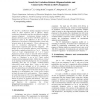139 search results - page 24 / 28 » Alignment-Free Phylogenetic Reconstruction |
NIPS
2007
13 years 8 months ago
2007
We present a probabilistic approach to language change in which word forms are represented by phoneme sequences that undergo stochastic edits along the branches of a phylogenetic ...
TCBB
2008
13 years 7 months ago
2008
Abstract-- The Maximum Parsimony problem aims at reconstructing a phylogenetic tree from DNA sequences while minimizing the number of genetic transformations. To solve this NP-comp...
JCB
2000
13 years 7 months ago
2000
Multiple sequence alignments (MSAs) are frequently used in the study of families of protein sequences or DNA/RNA sequences. They are a fundamental tool for the understanding of th...
RECOMB
2006
Springer
14 years 7 months ago
2006
Springer
Abstract. So far, most methods for identifying sequences under selection based on comparative sequence data have either assumed selectional pressures are the same across all branch...
CSB
2003
IEEE
14 years 21 days ago
2003
IEEE
We describe a method for finding ungapped conserved words in rRNA sequences that is effective, utilizes evolutionary information and does not depend on multiple sequence alignment...

